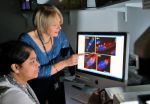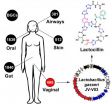(Press-News.org) Dartmouth researchers studying cell division in fruit flies have discovered a pathway that may improve understanding of molecular mistakes that cause older women to have babies with Down syndrome.
The study shows for the first time that new protein linkages occur in immature egg cells after DNA replication and that these replacement linkages are essential for these cells to maintain meiotic cohesion for long periods.
The study appears in the journal PLOS Genetics. A PDF is available on request.
As women age, so do their eggs and during a woman's thirties, the chance that she will conceive a Down syndrome fetus increases dramatically. Most such pregnancies arise from mistakes in a process called meiosis, a specialized cell division that creates gametes, or sex cells (sperm and eggs). Mistakes in meiosis can lead to gametes with the wrong number of chromosomes, which can cause Down syndrome. In Down syndrome, the fetus inherits three copies of chromosome 21 (trisomy 21). Chromosome segregation errors in oocytes, or immature egg cells, are the leading cause of birth defects and pregnancy loss in humans. By the time a woman reaches her late thirties, the probability that she will conceive a fetus with the wrong number of chromosomes exceeds 30 percent. This phenomenon is known as the maternal age effect, and although it has been well-documented, researchers are only beginning to understand the molecular mechanisms that may be responsible.
Accurate chromosome segregation during meiosis depends on protein linkages, or cohesion, that hold together sister chromatids, which are identical copies of a replicated chromosome. Recent evidence from Dartmouth and other laboratories indicates that meiotic cohesion weakens over time, contributing to the maternal age effect. The widely held view is that under normal conditions, meiotic cohesion is only established once, when the oocyte undergoes DNA replication. This means that a prerequisite for error-free segregation in human oocytes is that meiotic cohesion established in oocytes during fetal development must remain intact for decades (until menopause). A gradual decline of cohesion over the years is thought to contribute to the maternal age effect. However, researchers at Dartmouth and elsewhere have questioned the likelihood that the original cohesive linkages generated in fetal oocytes remain intact on meiotic chromosomes for even five years, much less 25 years. An alternative possibility is that maintenance of meiotic cohesion is an active process that utilizes a specialized "rejuvenation" program to establish new cohesive linkages throughout the extended timeframe that oocytes remain arrested until ovulation.
Bickel established in a 2003 study that the fruit fly Drosophila can be used to study why more mistakes occur during cell division as eggs become older. In this latest research, she and her co-authors tested the hypothesis that oocytes possess an active cohesion rejuvenation program. They were able to reduce cohesion proteins in fruit fly oocytes after normal meiotic cohesion was established during DNA replication but before oocyte maturation and ovulation.
Their results show that when cohesion proteins are reduced in this manner, cohesion is lost prematurely and chromosomes missegregate during the meiotic divisions.
Their work provides the first demonstration that under normal physiological circumstances, generation of new cohesive linkages takes place in oocytes after meiotic DNA replication and that these replacement linkages are essential for oocytes to maintain meiotic cohesion for long periods of time.
"Whether rejuvenation of meiotic cohesion occurs in mammals remains to be demonstrated, but it is hard to understand why fruit flies would possess a mechanism to actively keep cohesion intact during a short time frame (six days) if no similar program exists during the much longer time frame that mammalian oocytes must maintain cohesion (months to years)," says Associate Professor Sharon Bickel, the study's senior author.
Under normal conditions, rejuvenation of cohesion in fruit fly oocytes ensures that the number of cohesive linkages is sufficient to promote accurate chromosome segregation. But when experimental techniques are used to force these cells to undergo "aging," cohesion is lost prematurely and chromosomes missegregate, according to Bickel's 2008 study. Therefore, under "aging" conditions, the normal rejuvenation pathway in fruit fly oocytes is incapable of sustaining cohesion.
"This raises that intriguing possibility that if a meiotic cohesion rejuvenation pathway also operates in human oocytes, its effectiveness may decline with age," Bickel says. "Cohesion defects may become pronounced in older women not because the original cohesive linkages finally give out, but because the rejuvenation program can no longer supply new cohesive linkages at the same rate at which they are lost. Further investigation of this possibility may change the way we think about the maternal age effect."
INFORMATION:
Associate Professor Sharon Bickel is available to comment at Sharon.E.Bickel@dartmouth.edu
Broadcast studios: Dartmouth has TV and radio studios available for interviews. For more information, visit: http://www.dartmouth.edu/~opa/radio-tv-studios/
Dartmouth study may shed light on molecular mechanisms of birth defects among older women
2014-09-11
ELSE PRESS RELEASES FROM THIS DATE:
The sound of an atom has been captured
2014-09-11
Researchers at Chalmers University of Technology are first to show the use of sound to communicate with an artificial atom. They can thereby demonstrate phenomena from quantum physics with sound taking on the role of light. The results will be published in the journal Science.
The interaction between atoms and light is well known and has been studied extensively in the field of quantum optics. However, to achieve the same kind of interaction with sound waves has been a more challenging undertaking. The Chalmers researchers have now succeeded in making acoustic waves couple ...
New genetic targets discovered in fight against muscle-wasting disease
2014-09-11
Scientists have pinpointed for the first time the genetic cause in some people of an incurable muscle-wasting disease, Emery-Dreifuss muscular dystrophy (EDMD).
The international research team led by the University of Leicester say the finding of two target genes opens the possibility of developing drugs to tackle the disease in these patients. Their work has been published today in the journal PLOS Genetics.
The research was funded by The Wellcome Trust and was only possible by the University of Leicester team collaborating with groups in Germany (University of Greifswald), ...
New species of electrons can lead to better computing
2014-09-11
In a research paper published this week in Science, the collaboration led by MIT's theory professor Leonid Levitov and Manchester's Nobel laureate Sir Andre Geim report a material in which electrons move at a controllable angle to applied fields, similar to sailboats driven diagonally to the wind.
The material is graphene – one atom-thick chicken wire made from carbon – but with a difference. It is transformed to a new so-called superlattice state by placing it on top of boron nitride, also known as `white graphite', and then aligning the crystal lattices of the two materials. ...
'Hot Jupiters' provoke their own host suns to wobble
2014-09-11
Blame the "hot Jupiters."
These large, gaseous exoplanets (planets outside our solar system) can make their suns wobble when they wend their way through their own solar systems to snuggle up against their suns, according to new Cornell University research to be published in Science, Sept. 11.
Images: https://cornell.box.com/lai
"Although the planet's mass is only one-thousandth of the mass of the sun, the stars in these other solar systems are being affected by these planets and making the stars themselves act in a crazy way," said Dong Lai, Cornell professor of ...
Diversified farming practices might preserve evolutionary diversity of wildlife
2014-09-11
As humans transform the planet to meet our needs, all sorts of wildlife continue to be pushed aside, including many species that play key roles in Earth's life-support systems. In particular, the transformation of forests into agricultural lands has dramatically reduced biodiversity around the world.
A new study by scientists at Stanford and the University of California, Berkeley, in this week's issue of Science shows that evolutionarily distinct species suffer most heavily in intensively farmed areas. They also found, however, that an extraordinary amount of evolutionary ...
You can classify words in your sleep
2014-09-11
When people practice simple word classification tasks before nodding off—knowing that a "cat" is an animal or that "flipu" isn't found in the dictionary, for example—their brains will unconsciously continue to make those classifications even in sleep. The findings, reported in the Cell Press journal Current Biology on September 11, show that some parts of the brain behave similarly whether we are asleep or awake and pave the way for further studies on the processing capacity of our sleeping brains, the researchers say.
"We show that the sleeping brain can be far more ...
Gut microbes determine how well the flu vaccine works
2014-09-11
Annual flu epidemics cause millions of cases of severe illness and up to half a million deaths every year around the world, despite widespread vaccination programs. A study published by Cell Press on September 11th in Immunity reveals that gut microbes play an important role in stimulating protective immune responses to the seasonal flu vaccine in mice, suggesting that differences in the composition of gut microbes in different populations may impact vaccine immunity. The study paves the way for global public health strategies to improve the effectiveness of the flu vaccine. ...
Stem cells help researchers understand how schizophrenic brains function
2014-09-11
Using human induced pluripotent stem cells (hiPSCs), researchers have gained new insight into what may cause schizophrenia by revealing the altered patterns of neuronal signaling associated with this disease. They did so by exposing neurons derived from the hiPSCs of healthy individuals and of patients with schizophrenia to potassium chloride, which triggered these stem cells to release neurotransmitters, such as dopamine, that are crucial for brain function and are linked to various disorders. By discovering a simple method for stimulating hiPSCs to release neurotransmitters, ...
Intestinal bacteria needed for strong flu vaccine responses in mice
2014-09-11
Mice treated with antibiotics to remove most of their intestinal bacteria or raised under sterile conditions have impaired antibody responses to seasonal influenza vaccination, researchers have found.
The findings suggest that antibiotic treatment before or during vaccination may impair responses to certain vaccines in humans. The results may also help to explain why immunity induced by some vaccines varies in different parts of the world.
In a study to be published in Immunity, Bali Pulendran, PhD, and colleagues at Emory University demonstrate a dependency on gut ...
Our microbes are a rich source of drugs, UCSF researchers discover
2014-09-11
Bacteria that normally live in and upon us have genetic blueprints that enable them to make thousands of molecules that act like drugs, and some of these molecules might serve as the basis for new human therapeutics, according to UC San Francisco researchers who report their new discoveries in the September 11, 2014 issue of Cell.
The scientists purified and solved the structure of one of the molecules they identified, an antibiotic they named lactocillin, which is made by a common bacterial species, Lactobacillus gasseri, found in the microbial community within the vagina. ...


